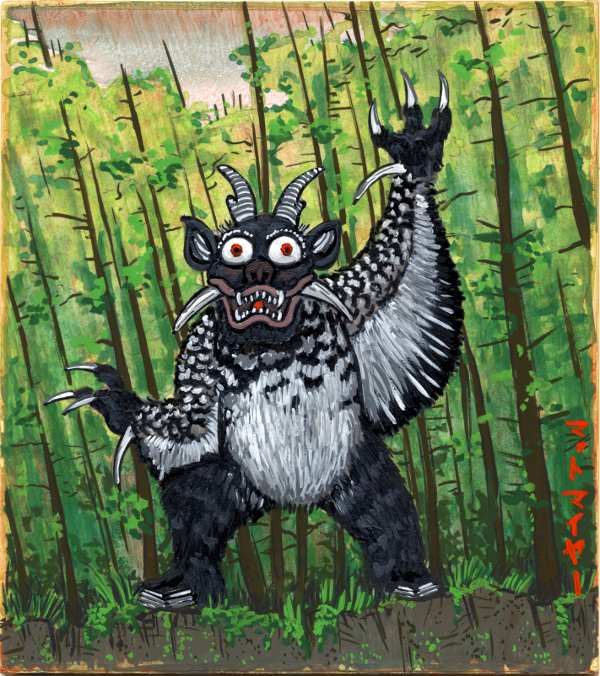Phew… today was a long day. Left the house at 8:30 and got home at 11:30… pm… A 15 hour day. But Wednesdays are my busiest day, and I knew that going into this project, so I was happy that I had done all of my research for this project last month. When I got home all I had to do was draw and paint! But like Monday, it was another all-nighter! Do to time constraints, this painting was done on a smaller shikishi than normal, so it only took about 4 hours instead of the usual 12. Anyway, it’s a strange and interesting yokai, so please read on!
Ushi-oni
Ushi-oni literally means “ox demon,” and as vague as that sounds, the creature itself is even more mysterious. There are many many different depictions of ushi-oni throughout Japanese folklore. It’s a common theme across the country, but it seems that every region of Japan has its own version of the ushi-oni, each one drastically different from the one before it.
You may remember the smaller one I painted last year as part of the Hyakki Yako panels (another all-nighter!). That one, admittedly, is my favorite depiction of the ushi-oni. Based on a painting by Sawaki Suushi, an 18th century painter who did a gorgeous yokai anthology called Hyakkai-Zukan, it depicts a monstrous crab-like beast with a hairy carapace and the head of a bull. It likes to attack fishermen, and is also often found working in cahoots with a nure-onna (which I will paint later this month, and which was also part of last year’s Hyakki Yakko panels). This ushi-oni is found in Shimane prefecture and around western Japan.
Another famous ushi-oni is from Ehime prefecture, most famous for its likely named festival, the Ushi-oni Matsuri. This yokai more resembles a Chinese dragon, with many dancers forming a head and a body, and with a long sword at the end of its tail. This ox demon is said to drive away evil spirits.
There are many others, however the one I bring you today comes from Negoro-ji temple in tiny Kagawa prefecture, Shikoku (also the location of the strange Japanese movie, Battle Royale). This guy has tusks, wrist spurs, flying-squirrel-like wings, and is not a jovial bovine. About 400 years ago he terrorized the area until he was slain by a famous archer. The archer dedicated the creature’s horns to the temple, where they can still be seen today! And in the monster’s memory a large statue was erected. I hope I can visit it some day… and then go get some yakiniku!

Ushi-oni
Etsy prints will be available very soon! Please bear with me a bit longer, until I have a day where I don’t have to pull an all-nighter to finish. 😉 | 今日も大変忙しかったです。8時30分に家を出て、帰ったのは23時30分でした。水曜日は一週間の中で最も忙しい日なのでいつもの事ですが、今月は妖怪月間ですからさらに忙しいです。
しかし良い点もあります。先月のうちに妖怪についてのリサーチをしておいたので、後は絵を書いて紹介するだけになって時間が省けています。
今日も夜通し絵を描く事になりましたが、今日の絵は小さいサイズの色紙なので通常12時間程かかる所が4時間程でできました。
今回の妖怪は大変おもしろい内容ですよ。是非読んでみてください。
「今日の妖怪シリーズ」今日は牛鬼です。
牛鬼はとてもミステリアスな妖怪です。色々な地域によって様々なストーリーがあり、それぞれ全く異なった形で伝えられています
牛鬼も昨年の「今日の妖怪シリーズ」の中の「百鬼夜行」に描いていますので見つけてみてくださいね。
牛鬼の絵はいくつかありますが、私が一番好きなのは佐脇嵩之の描いたものです。彼は18世紀に活躍した画家で、百怪図鑑を描いた方でもあります。彼の描く牛鬼は毛深い甲羅と雄牛の頭がある奇怪なカニのような形をしており、漁師を襲うとされています。よく濡女(ぬれおんな)と共に見られるといわれ、このタイプの牛鬼は島根県で伝えられいるものです。
愛媛県に伝わっている牛鬼は有名で、お祭りの名前にもなっています。この祭りでは、中国でみられる人間が操る龍舞いのような形態の牛鬼が登場し、尻尾には長い剣がついているそうです。この牛鬼は災いを払うとの言い伝えがあるといわれています。
香川県に伝わっている話では、牛鬼には牙や手首のけづめがあり、モモンガのような羽があったそうです。
400年程前、その牛鬼はこの地域一帯で脅威の存在でしたが、山田蔵人高清という有名な弓の名人が牛鬼を退治してその角を切り取り、当山に奉納したと伝えられています。驚いたことに、現在でもその角は現存しているそうです!いつか訪れてみたいと思います。

牛鬼
「牛鬼」の絵は私のEtsyストアでもうすぐ購入が可能になります。オリジナルの「牛鬼」の購入がご希望でしたら、こちらのお問い合わせフォームからご依頼をおねがいします。世界に1枚のオリジナルですので、売れてしまう場合もございます・・・。ご注文はお早めに。

Hey sorry this is probably really random, however I’m looking for reference and literature about Japanese folklore, stories about oni’s and dragons etc.. I’m getting my back and leg tattooed entirely in one large japanese peice and was trying to find a great folklore story of a fight between 2 characters that will be a good subject for my peice… However I can’t find much reference in the way of stories or books etc.. If you could perhaps point me in the right direction to where you found all this stuff out?
There’s really not much information available in English, which is why I wrote my book, to fill that gap. There are a few books on yokai that you can find on Amazon.com, however, and you can also find a fair amount of information on Wikipedia. There are a number of legends about samurai like Minamoto no Yorimitsu fighting giant monsters; Momotaro is a famous story about a boy who fights an oni, and Kintaro is another legendary warrior character. Try doing a google search for those names and see what comes up. I hope you’ll find what you’re looking for!
Pingback: 10 Japanese Monsters That Will Kill You – QS Daily